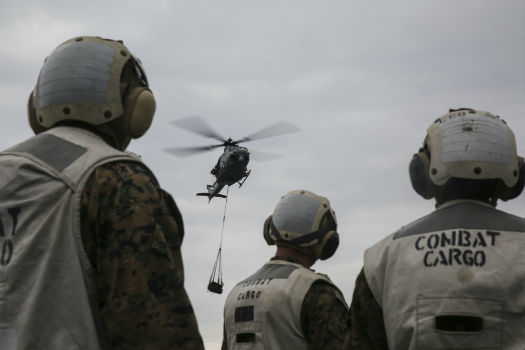
Landing support specialists wait for a UH-1Y Huey attached to Marine Medium Tiltrotor Squadron 262 (Reinforced), 31st Marine Expeditionary Unit, to drop off a load of tires during a helicopter support team exercise on the flight deck of the USS Bonhomme Richard (LHD 6). U.S. Marine Corps/Lance Cpl. Ryan C. Mains Photo
With the sound of a UH-1Y Huey approaching, Staff Sgt. Davon Simmons eagerly watches his Marines get ready to attach cargo to the bottom of the hovering aircraft for the first time at sea.
Marines from Combat Logistics Battalion 31, 31st Marine Expeditionary Unit, honed their skills during a helicopter support team exercise with Marine Medium Tiltrotor Squadron 262 (Reinforced), 31st MEU Feb. 6 on the flight deck of the USS Bonhomme Richard (LHD 6) while at sea.
“Doing the HST on ship is a newer experience for my Marines, so it was their first time being able to do anything on this scale,” said Simmons, the landing support platoon sergeant with CLB 31, 31st MEU. “I’m looking to see the progression and the efficiency to be able to hook-up the load and carry on with the mission.”
Lance Cpl. Braxton Bryant is one of the Marines on the team doing this for the first time at sea.
“I get an adrenaline rush every time,” said Bryant, a landing support specialist from Tallassee, Alabama. “We are the guys that go out there and get the load ready.”
While on the ship’s flight deck, Bryant and his fellow Marines found out that a simple task can become difficult due to the rocking waves.
“On land we have a stationary position and a solid base,” said Simmons, from Beaufort, South Carolina. “On ship we deal with the constant motion of the ocean along with the rotor wash from the aircraft, so there are a lot more things that could potentially go wrong.”
Simmons’ primary focus was the absolute safety of his crew.
“Some safety precautions we took (was to keep) every Marine that was on the ground near the inboard side of the cargo so falling overboard was less possible,” said Simmons. “Also, debris could be blown into the rotors and cause the aircraft to crash down on the Marines, so before starting we make sure the flight line is clear of any debris.”
The team plans to take on more complicated HST sea-based missions in the future during the 31st MEU’s Spring Patrol of the Asia-Pacific Region.
“We train for this all the time, so whenever we need to actually do this in a real life scenario, we won’t have to worry about making simple mistakes,” said Bryant. “We will be ready when we are needed.”









